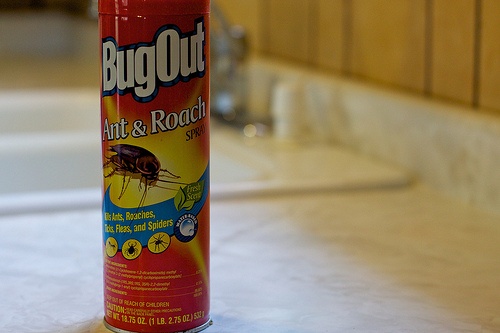It ain’t pretty, but it gets the job done.
A buzz haircut is how the military traditionally keeps hair out of soldiers’ eyes.
Huge critical areas buffers might be similar: they’re not individually tailored to each property owner – but they could keep toxic runoff out of the Salish Sea.
“There’s no simple answer to the question of how wide buffers should be,” said local scientist Russel Barsh. “It depends a lot on local soils and the kinds of vegetation involved.”
Barsh does have locally collected data that shows deadly levels of toxics are being washed into local waters – not from Seattle’s industrial areas, not from Vancouver Island’s stone-age sewage practices, but from homes and roads in the San Juan Islands.
His studies indicate that local road runoff and commercial termite and ant control spraying may be two of the county’s biggest sources of pollution lethal to fish, pollinators and other insects.
Last year Kwiaht studied whether runoff from Eastsound had any measurable toxic effect on clams in East Sound.
“Clams closest to the town storm sewer outfall had about 10 times the load of pesticides as clams from, for example, Buck Bay and White Beach, that should be affected only by the “regional signal” of toxics circulating in the Sound and Gulf of Georgia generally,” said Barsh. “This year’s question was whether freshwater fish in the main stream on San Juan Island are contaminated by activities on the island. We were able to look for a wider range of toxic substances, and found them all in local fish.”
The study discovered toxic loading of San Juan Island fish at levels of four micrograms of pyrethroid pesticides per kilogram of fish, and 15 micrograms of nonionic surfactants per kilogram of fish.
“The biggest signals were nonionic surfactants (industrial detergents/wetting agents) and polycyclic aromatic hydrocarbons (from incompletely burnt motor oils and fuels, chiefly in road runoff),” he said.
All study results, as well as a toxicity study, are available online here.
Barsh is concerned about nonionic surfactants, which are added to all sprayed pesticides so that they can be effectively sprayed. Although current federal and state laws treat the added surfactant as “inert ingredients” and do not require that the manufacture disclose their identity or concentration, “Usually there are far more nonionic surfactants in the product than “active ingredients,” he said. “Surfactants are toxic to insects and other animals, and nonionic surfactants break down into nonyl phenol, an endocrine disrupter. When islanders spray pesticides, they are spraying … a kind of detergent that is estrogenic and can keep fish from reproducing.”
“The bottom line is this: islanders’ activities do contaminate our local fish and shellfish at levels that, from lab experiments, are high enough to have adverse biological effects.”
Pesticides can break down quickly or persist in the environment indefinitely, depending on their chemical makeup and the conditions.
What can we do?
1. Read labels, and choose the least toxic option.
Which chemicals you use can make a huge difference, said Barsh. Before you spray for wasps, check the label; if you’ve hired a commercial company to spray for termites or carpenter ants, ask what chemicals they are going to use.
“There is no such thing as a “safe” or “non-toxic” pesticide,” said Barsh. “We can easily avoid the worst ones, however!”
He asked islanders to avoid the following active ingredients, which are 10 to 1,000 times more toxic to local fish than alternative chemicals: bifenthrin, fenvalerate, esfenvalerate, tralomethrin, deltamethrin, cyfluthrin, and cypermethrin.
“None of the chemicals I just listed should be used in the islands where we are all so close to the water,” said Barsh. But bifenthrin is by far the most toxic, and Barsh calls it “the nuclear option” of pest control.
“The lethal dose of bifenthrin to salmon is 0.15 micrograms (millionths of a gram) per kilogram of fish. A sockeye weighs about a kilogram or two, so 0.15 to 0.30 micrograms is enough to kill it,” said Barsh. According to manufacturers instructions, he has calculated that for a single pest control treatment, the amount of bifenthrin sprayed on the foundation of a 1000 square foot house is just under one gram.
“Many island landowners have had their house treated 6-12 times a year, which means discharging up to about 10 grams of bifenthrin into the environment each year for one 1000 square foot house. If 500 houses do the same thing, we are talking 50 kg of bifenthrin.”
Although the chemicals washed into local waters are diluted, they do continue to accumulate. Barsh found about 4 micrograms/kg of pyrethroid pesticides, the chemical family that includes bifenthrin, in the fish in False Bay.
“Termite and ant killing products using the chemical allethrin are less than 1% as toxic to fish, invertebrates, and pollinators as products that contain bifenthrin. Both allethrin and bifenthrin products are currently used in San Juan County. It’s for consumers to choose,” he said.
2. Safely dispose
If you find you have bifenthrin or another of the listed “worst toxics” in your home, you may want to safely dispose of them. Unused pesticides should be regarded as toxic waste. The county has periodic toxic-waste pickup days on each island, organized by Helen Venada at SJC Public Works. Her email address is helenv@sjcpublicworks.org.
Brian Rader, SJC Pollution Prevention Specialist, can provide tips on storing pesticides safely. His email address is brianr@co.san-juan.wa.us.



